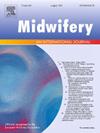Exploring factors influencing paternal-fetal attachment: A systematic review and meta-analysis
IF 2.5
3区 医学
Q1 NURSING
引用次数: 0
Abstract
Background
Paternal-fetal attachment contributes to positive pregnancy outcomes and early child development. Although numerous factors influencing paternal-fetal attachment have been extensively reported, these findings have not been systematically synthesized.
Objective
This study aimed to systematically evaluate the levels and influencing factors of paternal-fetal attachment, identify statistically significant determinants, and determine the effect sizes of these factors.
Data sources
Medline, CINAHL, CNKI, Wanfang, Web of Science, Ovid, Scopus, PsycINFO, and Cochrane Library.
Methods
A comprehensive search was conducted across 7 English-language databases and 2 Chinese-language databases, covering the period from January 2014 to October 2024. The study included survey-based research (both cross-sectional and longitudinal studies) as well as qualitative studies. Quality assessment was performed using the Agency for Healthcare Research and Quality (AHRQ) tool, the Newcastle-Ottawa Scale (NOS), and the Critical Appraisal Skills Programme (CASP). Meta-analysis was conducted using RevMan Manager 5.4 software, and narrative synthesis was employed for data that were unsuitable or unable to undergo meta-analysis.
Results
This systematic review and meta-analysis included 25 studies, with 17 studies (involving 2643 expectant fathers) contributing to the meta-analysis. The overall level of paternal-fetal attachment was 3.57 (95 % CI: 3.26–3.88), indicating a moderate level of attachment. Key factors influencing paternal-fetal attachment included positive emotions, partner support, and maternal-fetal attachment, which had moderate effect sizes, suggesting their substantial role in fostering paternal attachment. Other significant factors with smaller effect sizes included age (older fathers reported slightly lower attachment), pregnancy planning status (planned pregnancies were associated with stronger attachment), parity (first-time fathers showed higher attachment), and psychological factors such as anxiety, depression, and negative emotions, which were negatively associated with attachment. Additionally, marital status and marital quality were positively linked to attachment, though their effects were small. These findings highlight the importance of emotional, relational, and psychological factors in shaping paternal attachment during pregnancy.
Conclusions
This systematic review offers a comprehensive overview of paternal-fetal attachment and identifies key predictive factors, including positive emotions, partner support, maternal-fetal attachment, and psychological well-being. The findings underscore the importance of addressing emotional, relational, and contextual factors to enhance paternal involvement during pregnancy. These insights can guide future research and inform evidence-based practices aimed at supporting paternal emotional well-being and fostering stronger family dynamics during the prenatal period.
探讨影响父胎依恋的因素:系统回顾和荟萃分析
父胎依恋有助于妊娠结局和儿童早期发育。虽然有许多影响父胎依恋的因素被广泛报道,但这些发现并没有被系统地综合。目的系统评价父胎依恋水平及其影响因素,找出具有统计学意义的决定因素,并确定这些因素的效应量。数据来源:medline、中国科学院、中国知网、万方网、Web of Science、Ovid、Scopus、PsycINFO、Cochrane Library。方法综合检索7个英文数据库和2个中文数据库,检索时间为2014年1月至2024年10月。该研究包括基于调查的研究(横断面研究和纵向研究)以及定性研究。质量评估采用卫生保健研究和质量机构(AHRQ)工具、纽卡斯尔-渥太华量表(NOS)和关键评估技能计划(CASP)进行。采用RevMan Manager 5.4软件进行meta分析,对不适合或无法进行meta分析的数据采用叙事综合。结果本系统综述和荟萃分析包括25项研究,其中17项研究(涉及2643名准爸爸)对meta分析有贡献。父胎依恋的总体水平为3.57 (95% CI: 3.26-3.88),表明依恋水平中等。影响父胎依恋的关键因素包括积极情绪、伴侣支持和母胎依恋,它们具有中等效应量,表明它们在培养父亲依恋中起着重要作用。其他影响较小的重要因素包括年龄(年长的父亲报告的依恋程度略低)、怀孕计划状态(计划怀孕与更强的依恋相关)、胎次(第一次父亲表现出更高的依恋),以及心理因素,如焦虑、抑郁和负面情绪,这些因素与依恋呈负相关。此外,婚姻状况和婚姻质量与依恋呈正相关,尽管它们的影响很小。这些发现强调了情感、关系和心理因素在塑造怀孕期间父亲依恋的重要性。本系统综述对父胎依恋进行了全面的概述,并确定了关键的预测因素,包括积极情绪、伴侣支持、母胎依恋和心理健康。研究结果强调了处理情感、关系和环境因素对提高怀孕期间父亲参与的重要性。这些见解可以指导未来的研究,并为以证据为基础的实践提供信息,旨在支持父亲的情感健康,并在产前期间培养更强的家庭动力。
本文章由计算机程序翻译,如有差异,请以英文原文为准。
求助全文
约1分钟内获得全文
求助全文
来源期刊

Midwifery
医学-护理
CiteScore
4.50
自引率
7.40%
发文量
221
审稿时长
13.4 weeks
期刊介绍:
Midwifery publishes the latest peer reviewed international research to inform the safety, quality, outcomes and experiences of pregnancy, birth and maternity care for childbearing women, their babies and families. The journal’s publications support midwives and maternity care providers to explore and develop their knowledge, skills and attitudes informed by best available evidence.
Midwifery provides an international, interdisciplinary forum for the publication, dissemination and discussion of advances in evidence, controversies and current research, and promotes continuing education through publication of systematic and other scholarly reviews and updates. Midwifery articles cover the cultural, clinical, psycho-social, sociological, epidemiological, education, managerial, workforce, organizational and technological areas of practice in preconception, maternal and infant care.
The journal welcomes the highest quality scholarly research that employs rigorous methodology. Midwifery is a leading international journal in midwifery and maternal health with a current impact factor of 1.861 (© Thomson Reuters Journal Citation Reports 2016) and employs a double-blind peer review process.
 求助内容:
求助内容: 应助结果提醒方式:
应助结果提醒方式:


